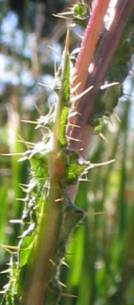
A PLANTING SCHEME FOR MINGERTON
A Report by Nelly Moser
Berkheya purpurea
A fast-growing, long-lived perennial, Berkheya purpurea has a long, single taproot and forms a dense clump of very prickly foliage tight on the ground. The large green leaves arranged in a rosette are up to 250 mm long with wavy, very spiny edges. The upper surfaces of the leaves are almost shiny, whereas the cobwebby undersides are covered with long, soft, white hairs. Smaller leaves are produced along the single flowering stem; these leaves diminish in size upwards and their bases continue down the stem forming broad spiny wings running down the stem-an interesting feature of Berkheya purpurea.
The strong flower stem is produced in summer in the centre of the plant, and it can stand up to a metre tall. They are protected by large, spiny green bracts which fold open with the flowers to form a flat shield at the back and close again after flowering to protect the seed heads. Each flower lasts a few days and a single plant can have up to 15 flowers open at one time.
Every part of this attractive plant is spiny and is capable of inflicting a lot of pain on the unwary vandal. I would recommend its planting in the raised bed in the courtyard and in all the beds surrounding the building.
Ruta graveolens (Rue)
Evergreen perennial bush with yellow flowers and blue-green attractive frondy foliage. Also known as Herb of Grace (repentence) due to its bitter taste. It was believed hundreds of years ago that Rue would guard against witches, and innkeepers would give some to travellers for safety. Grows to about 3 ft (92 cm) high. Very aromatic. Makes a strong disinfectant and insect repellent when leaves are strewn across the floor.
Dioscorides recommended it for the treatment of snakebite, as he reckoned that weasels ate the leaves before fighting snakes. He also claimed it had contraceptive properties. Plant Rue round buildings to keep out snakes. In Medieval and Tudor times it was one of the main ingredients for exorcism. Juice has been used for earache.
Plant in a sunny site and cut back by half in spring to keep it compact. Plant lasts longer in poor, dry soil than good soil.
CAUTION - SEVERELY TOXIC TO SKIN WITH SUNLIGHT (the sap may render the skin excessively sensitive to strong sunlight resulting in painful blistering, so handle with care)
This plant has a multitude of uses. Insects, snakes and witches are repelled. Its disinfectant properties will be useful, as will its properties as a cure for earache as this is a frequent hazard in our work. It should also prove to be vandal-resistant thanks to its toxic properties. I recommend planting it all round the building and also in window boxes to maximise its snake and witch repelling properties.
Pyracantha coccinea ‘Red Column’ Firethorn
A vigorous plant with small evergreen, oval, dark green leaves. Bears corymbs of tiny white flowers at the end of spring, which are followed by long lasting scarlet berries. Best grown in well-drained soil in full sun or part shade. As its name suggests it’s a thorny plant. I would advise training it up walls to discourage visitors and clients from entering and leaving the building through windows.
 Berkheya Purpurea
Berkheya Purpurea
Ouch!
2 comments:
This is my third attempt to post a comment here - Eva keeps interrupting - shes asleep now TG! I love this piece - I think it should be a regular feature. I have a challenge though - are there any hardy shrubs that can withstand D's "lawnmower culling"
There are hardy shrubs that can withstand many trials but none that can fight off the trauma of whirring slicing blades.
Tell him to be more careful.
Post a Comment